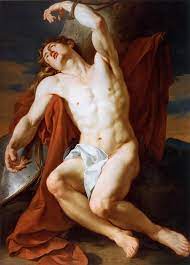 The Martyr de saint Sebastien (Also known as The Martyrdom of St Sebastian) is an oil canvas painting of the religious art genre conceived by François-Guillaume Ménageot during the second half of the eighteenth century. Standing 52.5 inches in height and 38.3 inches in weight, it currently resides within the collection of the Patrick and Beatrice Haggerty Museum of Art. François-Guillaume Ménageot, who lived from 1744 to 1816, was a French painter who specialized in works revolving around religious implications as well as French historical scenes.
The Martyr de saint Sebastien (Also known as The Martyrdom of St Sebastian) is an oil canvas painting of the religious art genre conceived by François-Guillaume Ménageot during the second half of the eighteenth century. Standing 52.5 inches in height and 38.3 inches in weight, it currently resides within the collection of the Patrick and Beatrice Haggerty Museum of Art. François-Guillaume Ménageot, who lived from 1744 to 1816, was a French painter who specialized in works revolving around religious implications as well as French historical scenes.
Ménageot worked as an artistic pupil and trained under the guidance of first Jean-Baptiste-Henri Deshays, then Joseph-Marie Vien, and lastly Francois Boucher. It was through Boucher’s influence that warm, light attributes and colorations were arrogated into Ménageot’s earlier works. In 1766, he won the Grand Prix de Rome with his work, Tomyris Plunging the Head of Cyrus into a Bowl of Blood, which also achieved the opportunity to stay at the French Academy in Rome from 1769 to 1774. He was then approved as a history painter in 1777, and his work was an immense influence on the French painters of his time. He guided the art world to re-adapt the “Grand Style” of painting, which consisted of compositions of the horizontal stature, an influx of sculptural drapery, and colder-toned colors.
The painting itself is Ménageot’s representation of Saint Sebastian, who serves as a protector against plagues, as well as a patron of soldiers, athletes, and specifically archers. He is often depicted as unclothed, tied to a tree, wearing a crown, and shot with arrows. Saint Sebastian often served as the muse for painters, although the reasoning for this varies depending on the time period. Specific saints were prioritized over others in the art world based on their morals that saintly figures who had fulfilled prayers and acknowledged miracles were ones who could be depicted in churches, sanctuaries, chapels, etc. Due to this, most saw Sebastian as one of the only opportunities (other than Jesus himself) to study and perfect their abilities of male autonomy during the Renaissance, because interest was primarily focused on the symbolic meaning rather than the style, or naked body. Furthermore, art was directed by the concept of “art for art’s sake;” the spirituality of the painting.